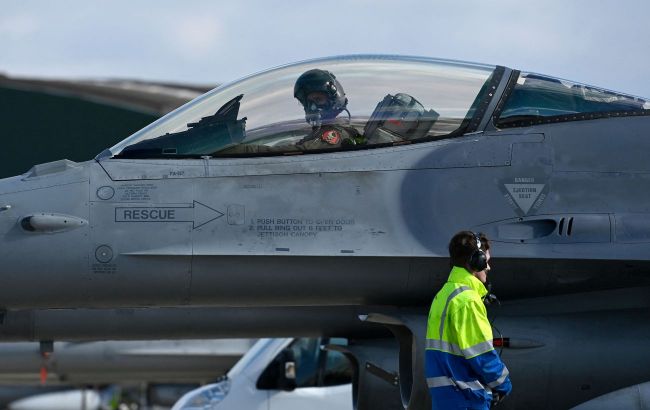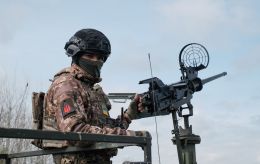Why Russia targeted Western Ukraine, what it has to do with F-16s: Expert explains enemy's strategy
 F-16 aircraft (Getty Images)
F-16 aircraft (Getty Images)
The Russian army has aimed to strike specifically at the western regions of Ukraine lately. Reliable sources of the Financial Times have reported that the enemy targets airbases, runways, and pilots who are located far from the frontline.
What plans does Russia have while striking the western parts of the country, and how does this relate to the F-16 fighter jets? Read more below in the RBC-Ukraine article.
Attacks on Western Ukraine: What is known
Russian aerial attacks on Ukraine take place on a daily basis. However, in recent days, the enemy's attention has shifted to the western part of the country. On August 15, Russia launched a mass missile strike deep within Ukrainian territory. The enemy used at least 28 missiles of various types. 16 of them were successfully intercepted by air defense forces.
The consequences of this attack were felt in Lviv, where a missile hit the courtyard of a preschool. In Lutsk, an industrial facility producing automotive components was struck. On the same day, air defense systems were activated in the Ivano-Frankivsk region.
Moreover, these aerial incidents extended to other regions including Dnipro, Smila, and the Khmelnytskyi region.
Before that, on August 11, Russian forces attempted to target an infrastructure object in the Ivano-Frankivsk region using aeroballistic missiles. One of the missiles hit a private residence in the Kolomyia district, where a family with three children lived. An 8-year-old boy tragically lost his life.
Later, the Spokesperson of the Air Forces Command of the Armed Forces of Ukraine Yurii Ihnat said the enemy's missiles had targeted military airfields that have been within Russia's special interest for several months.
"Starokostyantyniv air base is currently suffering the most from the consequences of the strikes. Now, it's the Ivano-Frankivsk region. Our young pilots, who will soon be training on F-16 jets, have been targeted. They wanted to hit our youth and deprive us of the prospect of transitioning to Western technology," Ihnat said.
In addition, the attacks on infrastructure were briefly commented upon by Mykola Urshalovych, a representative of the National Guard. According to him, Russian forces targeted three critical state facilities over the past week.
"Last week, the occupiers struck three crucial state facilities in the Dnipropetrovsk and Lviv regions, guarded by the National Guard. National Guard forces, in close cooperation with rescue services, worked to eliminate the consequences of enemy strikes," said Urshalovich during the briefing, without providing additional details.
Western Ukraine becomes a new target for the occupiers, according to FT
As the reputable British media Financial Times reports, Russia's intensified attacks on deep areas within Ukrainian territory seem to have a particular goal: to neutralize Ukraine's capability to launch long-range missiles acquired from ally states.
The journalists emphasize that this week Moscow launched dozens of missiles deep into western Ukraine, targeting airbases, runways, and pilot training centers located up to 1000 km from the frontline.
According to sources cited by FT, Ukraine considers these attacks as part of the occupiers' plan to destroy Ukrainian runways and bomber parks, which were used for launching British Storm Shadow missiles and French Scalp missiles.
"To avoid missile and drone strikes, Ukrainian flyers constantly relocate critical weaponry and trained personnel, with pilots operating from dozens of airbases and commercial airports across Ukraine," the media says.
Russia's strategy explained by an expert
A military-political expert from the Information Resistance project, Oleksandr Kovalenko, told RBC-Ukraine that the Russian army is currently aiming its attacks at Ukrainian airfields and runways.
And here lies an important nuance. To receive F-16s in the future, Ukraine needs properly equipped airfields with appropriate infrastructure.
"In other words, it's about modernizing existing ones or building new ones. But constructing a new airfield isn't feasible due to the time it would take. Therefore, the focus is on modernizing airfields that are as far away from the frontline as possible, where they can't be easily targeted. We're talking about the western part of Ukraine," Kovalenko explains.
Hence, the airfields that can be used, for instance, for a squadron of light fighters like the F-16, are the ones Russia is attempting to strike now, according to the speaker.
"Additionally, speaking about Kolomyia, it's already known that the Russians attempted to target pilots who were planning to travel to Europe for F-16 training. So, the Russians are trying to act preemptively," Kovalenko noted.
Currently, the occupiers aim to strike both personnel deployment sites for those training on F-16s and the airfields where Western aircraft could potentially be stationed.
"The airfield where F-16s will be stationed must have air defense systems on par with those in Kyiv and the region. It requires a high level of redundancy and technical sophistication. Because if the Russians manage to breach the air defense and strike that airfield, even if the F-16s are in the air, and the enemy only manages to destroy the runway or buildings, the planes will have nowhere to land," the expert underscores.
As for the Su-24, which carries Storm Shadow missiles the Russians targeted, the situation is simpler. Since this aircraft can take off from any airfield in various regions of the country and fly to another.
"But for the F-16, there's a problem because they will have only one designated airfield. And if that one gets destroyed, there will be nowhere to return. Only to the West, to Poland or Romania. Therefore, the anti-air defense must be at a sufficiently high level," the expert concluded.

